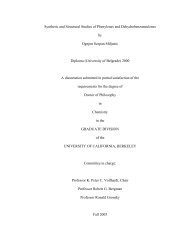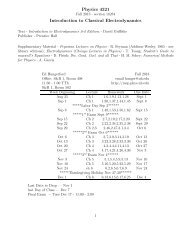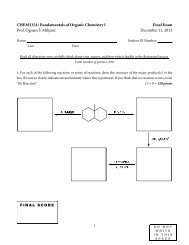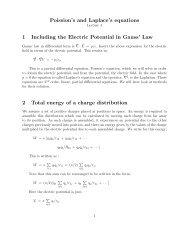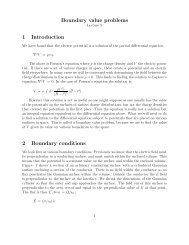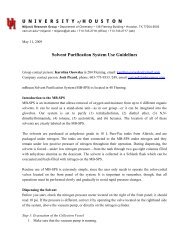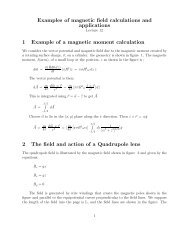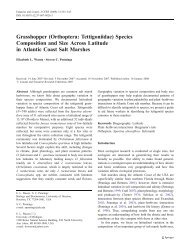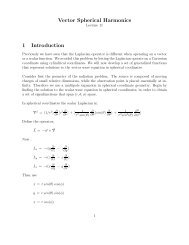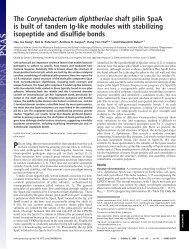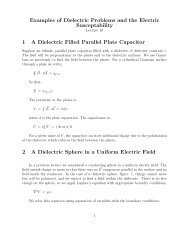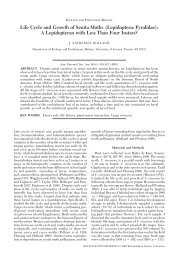Scattering 1 Classical scattering of a charged particle (Rutherford ...
Scattering 1 Classical scattering of a charged particle (Rutherford ...
Scattering 1 Classical scattering of a charged particle (Rutherford ...
Create successful ePaper yourself
Turn your PDF publications into a flip-book with our unique Google optimized e-Paper software.
For a random distribution <strong>of</strong> a large number <strong>of</strong> <strong>scattering</strong> centers the phase difference betweenthe points causes the structure factor,F(q), to average to zero unless j = n. Whenj = n, the sum results in F(q) = N, the number <strong>of</strong> <strong>scattering</strong> centers. On the other handif the <strong>scattering</strong> centers are distributed in an ordered array then F(q) is small unless ⃗q ≈ 0.This is coherent <strong>scattering</strong>. Thus consider the form in 1-D;∑e i⃗q·(⃗x j−⃗x n) → ∑ e iqx je iqxnjnjnNow let x j = jd where d is the spacing <strong>of</strong> the centers. The sum is converted to an integral by;1 = [(j + 1) − j] = (δj) = [x j+1 − x j ]/d = ∆x/d∞∑j=−∞e iqx k =∑ (δj)eiqx k = (1/d)∞∫−∞dxe iqx k=δ(q)2πdFinally suppose the centers are distributed by some function f(⃗r) so that ⃗pf(⃗r) representsthe electric dipole moment per unit volume (use the electric moment here but it is obvioushow to include the magnetic moment). The <strong>scattering</strong> due to this distribution is ;dσdΩ =k4(4πǫ) 2 | ∫ d 3 x ′ (â · ⃗p) f(⃗r ′ ) e i⃗q·⃗x′ | 2which we re-write as previously;anddσ sdΩ =k4(4πǫ) 2 |[â · ⃗p] 2F(q) = | ∫ d 3 x ′ f(⃗r ′ )e i⃗q·⃗x′ | 2dσdΩ = dσ sdΩ F(q)The structure function (form factor) is the Fourier transform <strong>of</strong> the spatial distribution <strong>of</strong>the <strong>scattering</strong> centers.6 Expansion <strong>of</strong> a plane wave in spherical harmonicsThe <strong>scattering</strong> problem is solved naturally in spherical coordinates, as the center <strong>of</strong> the coordiantesystem is chosen to lie at the center <strong>of</strong> the scatttering source. Also the <strong>scattering</strong>solution is to be obtained in a multipole series as the <strong>scattering</strong> amplitude is observed as thedistance from the <strong>scattering</strong> center → ∞. However, a plane wave incident on the <strong>scattering</strong>center is formulated in Cartesian coordinates. Thus we must formulate the incident wave in8




